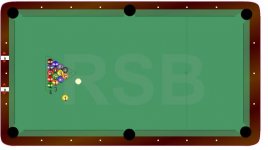I've had the sense that cues squirt more at higher speeds, though I haven't really measured the effect in any controlled way. The problem of course is that when you hit at higher speeds there's less swerve, and this gives the appearance of more squirt. Another problem is accuracy suffers at higher speeds, at least for some of us.
So to make squirt a bigger effect compared to swerve, I constructed the MIZ CUE FROM HELL. I thought about doing surgery on my Scruggs, Josey, etc. but then decided maybe it'd be better to choose the cue from my MIZ collection.
It looks like a normal cue, but suffice it to say proponents of backhand english--the kind where you just pivot about your normal bridge--would be scratching their head with one hand and their butt with the other after a few shots with the MIZ CUE FROM HELL. It has a pivot point of about 7 or 8 inches.
I don't really have results yet, but the exit polls are suggesting I might have been wrong about harder shots squirting more.
mike page
fargo
So to make squirt a bigger effect compared to swerve, I constructed the MIZ CUE FROM HELL. I thought about doing surgery on my Scruggs, Josey, etc. but then decided maybe it'd be better to choose the cue from my MIZ collection.
It looks like a normal cue, but suffice it to say proponents of backhand english--the kind where you just pivot about your normal bridge--would be scratching their head with one hand and their butt with the other after a few shots with the MIZ CUE FROM HELL. It has a pivot point of about 7 or 8 inches.
I don't really have results yet, but the exit polls are suggesting I might have been wrong about harder shots squirting more.
mike page
fargo
